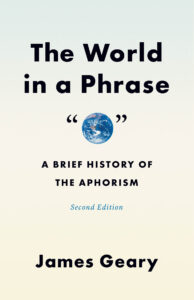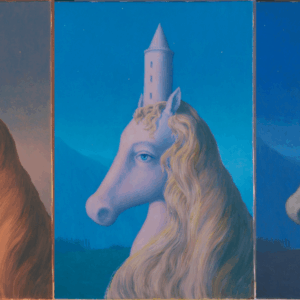
The Striking Similarities Between Aphorisms and Poetry
“Aphorisms and poems are always idiosyncratic, their output an image supercharged with storytelling specificity.”
Aphorisms and poems have a lot in common. Both are brief, both use vivid imagery, and both have a twist, some quick textual or psychological flip, a sudden sting in the tail that gives readers a jolt.
Ezra Pound is a case in point. What is the difference between his “In a Station of the Metro”
The apparition of these faces in the crowd:
Petals on a wet, black bough.
and his “The book should be a ball of light in one’s hand” that makes one a poem and the other an aphorism?
Some poets write verse that is simultaneously a poem and an aphorism. Emily Dickinson’s
Who goes to dine must take his Feast
Or find the Banquet mean—The
Table is not laid without
Till it is laid within.
is a rhyming aphorism written in the form of a quatrain, while Kay Ryan’s “Dry Things” is a rhyming aphorism written as a metaphysical fable
The water level
comes up when
you throw in
stones, bricks,
anything that
sinks. It’s a
miracle when
that works,
don’t you think?
Dry things letting us
drink?
The work of South Korean poet Lee Seong-bok inhabits the overlapping area in the Venn diagram of poetry and aphorism, a space that combines startlingly fresh metaphors with philosophical, psychological, and artistic insight.
Lee’s Indeterminate Inflorescence: Lectures on Poetry, a collection of aphorisms on how and why to write, is the model and manifesto both forms need at a time when generative AI programs like ChatGPT promise to do all our writing and reading for us and so much of our daily feeds are clogged with trash talk, hot takes, and byte-sized chunks of outrage.
“Living, seeing, and writing are the same thing. We must become poetry-writing machines.”
“My thoughts typically revolve around two axes: metaphor and aphorism,” Lee says. “I see them as opposing yet complementary. Truth is like the dark side of the moon—forever unseen. This is why we need metaphors and literature: They signal absence, like buoys in an ocean.”
Lee was a professor of French literature and creative writing for many years until his retirement in 2012. After retiring, he emailed his former graduate students, asking them to send him excerpts from the notes they had taken in his classes. The result is Indeterminate Inflorescence.
Lee’s aphorisms on writing often take the form of an ancient Korean poetic form, the sijo, a poem made up of three lines, which together amount to forty-five syllables. A sijo is a kind of roomier haiku, at least from a syllabic point of view.
The first line of a sijo states the theme of the poem; the second line elaborates on or embellishes the theme; and the third line introduces a surprise, akin to the twist that animates aphorisms, before completing the poem. The surprise can be a sudden interjection—like “Oh!”—or an abrupt shift in imagery or tone. One of Lee’s sijo-like three-line aphorisms is:
Think of what balconies would be like without railings. Only the railing keeps us from certain death. Writing is to get rid of this railing.
Indeterminate Inflorescence is divided into sections, such as “Poetry,” “Writing,” and “Life,” but it is clear that Lee’s poetics and his worldview are inseparable: “Living, seeing, and writing are the same thing. We must become poetry-writing machines.”
Of course, actual machines can already write accomplished poetry and aphorisms. Given the most basic of prompts, ChatGPT is quite adept at penning maxims, sonnets, haiku, and even serviceable sijos in English, Korean, or any language you wish.
AI performs in seconds formal tasks, like adhering to the complex rhyme and repetition scheme of a villanelle, that can take a human poet a lifetime to learn. Such systems, trained on pirated editions of copyrighted books and the vast anthology that is the internet, are far more widely read than a single person could ever be.
And if some AI-generated writing is bad, is it any worse than the bad writing humans are capable of producing?
Aphorisms “serve as a probe or compass to explore the threads of life and poetry.”
While the literary products of generative AI are increasingly indistinguishable from those of humans, the literary process is definitely not. Lee writes that we must “become” poetry-writing machines—and “becoming” is a process that can’t be offloaded onto a computer. The input for an aphorism or a poem is the lived experience of its author, something that can’t be simulated or homogenized. Platitudes feel trite because they’re generic, the literary equivalent of canned laughter. Aphorisms and poems are always idiosyncratic, their output an image supercharged with storytelling specificity.
Lee takes the old journalism dictum “Show, don’t tell” and applies it to the writing of aphorisms and poems, which—for me, at least—should always be shelved in the nonfiction section. As Lee puts it,
It’s difficult to say what the wind is, but we can show it. Details are like that. Details are the best instruments to convey feelings. A detail can take the place of so many words. For example, what would you call a five-year-old boy on the day of his father’s funeral as he plays by the funeral feast, blowing out candles?
Aphorisms and poems revel in cognitive effort; they don’t seek to minimize it like AI does. They always and deliberately leave something half-said, unsaid, or only suggested. Aphorisms and poems point to some strange or wonderful thing, but readers have to do the work of seeing it for themselves. This accounts for the intellectual thrill of reading these often difficult forms: It’s fun to figure stuff out for yourself! So Lee’s advice to writers is,
No matter how wonderful a thought, do not reveal it in a poem. Instead, let readers be prompted into having the wonderful thought on their own through reading your poem.
Aphorisms “serve as a probe or compass to explore the threads of life and poetry,” Lee says. “Poetry and aphorism exist together yet are also distinct. They accompany each other in that both float in the same stream of thought. Yet they differ in that aphorisms crystallize poetry, much like jewelry forged from a deceased person’s ashes—it’s the poetry’s ‘mummy.’”
Lee has described his process of living, seeing, and writing as “seeking what’s precious and dear in life, those few things that remain beneath the ashes of a house that’s burned to the ground.”
In “Your pain won’t make even a single leaf turn green”, an earlier collection of reflections on art and life not yet translated into English, Lee wrote, “To battle despair, one must create arbitrary despair. It is like setting a controlled fire to stop a forest fire: setting oneself ablaze to gain the world’s sarira.”
Lee’s aphorisms about poetry display this same seam, this trace of “becoming,” showing that it’s not flawlessness that matters but the process of putting things together, however imperfectly.
In Buddhism, sarira are pearl-like objects said to be found among the cremated remains of spiritual teachers and to confer blessings on those who encounter them. Sarira are an apt metaphor for aphorisms and poems—compressed, crystalline relics from an author’s intellect that offer wisdom to those who read them.
The moon jar is another distinctively Korean art form. These milky-white porcelain vessels, originally made to contain flowers or wine, got their name because they are large, round, and white, just like the full moon. In part because of their size, moon jars are assembled in two halves. And because the wet clay is so heavy, the halves tend to sag a bit in the kiln.
As a result, moon jars are never perfectly round, and a seam is always faintly visible where the two halves meet. This imperfection is considered an essential part of a moon jar’s charm and beauty.
Lee’s aphorisms about poetry display this same seam, this trace of “becoming,” showing that it’s not flawlessness that matters but the process of putting things together, however imperfectly. “Poetry is the restoration of the whole through details,” he writes. “Think of it as making a sketch of a face only briefly seen. Just as one puts together a shattered skull or an earthenware pot, poetry is the creation of the pieces that go in the spots where the original pieces are missing.”
__________________________________

This essay is adapted from James Geary’s The World in A Phrase: A Brief History of the Aphorism, out now from the University of Chicago Press.
James Geary
James Geary, the deputy curator at Harvard University’s Nieman Foundation for Journalism, is the author most recently of Wit's End: What Wit Is, How It Works, and Why We Need It.



















